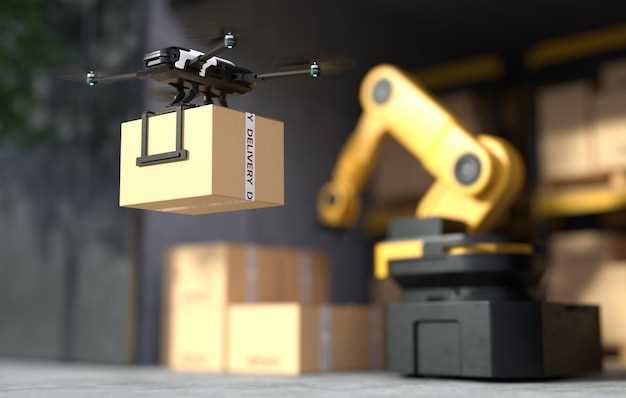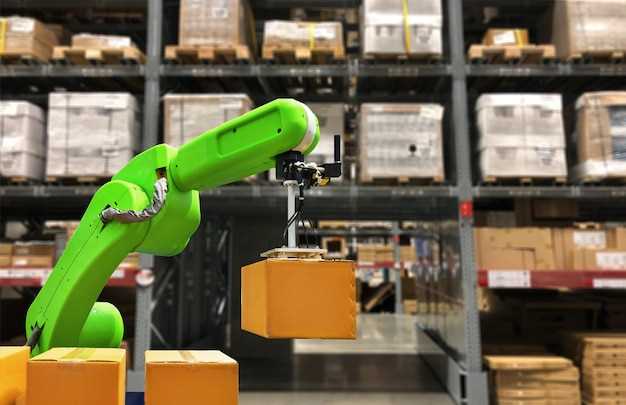Start with a compact fleet of autonomous mobile robots in high-throughput zones to accelerate fulfillment, delivering substantial gains in speed and safety. This automation reduces manual travel, helping workers stay focused on higher-value tasks while the system collects real-time data to inform daily decisions.
The robots perform a defined function: they collect items from shelves, confirm SKUs, and guide pickers through the floor without creating congestion. Through a centralized control layer, managers see task status, bottlenecks, and energy use, enabling faster decisions than manual scheduling alone. The approach maintains a wide scope of operations and sets the stage for scaling.
In practical terms, pilots show a substantial lift in throughput across a wide footprint: automated shuttles move products from receiving to put-away and then to picking zones with reduced travel time by 25–40% and error rates down 15–20%. The likely ROI appears within 12–18 months when integration includes a change management plan and staff training. To support action, addverbs in task labels clarifies actions for operators and systems alike.
To ramp safely, pair the tech with clear safety controls: secure zones, geo-fenced paths, and automated stop rules. Sécurité and auditability matter for executives tracking performance and protecting workers. Use a staged rollout: a two-week pilot, followed by 90 days of validation, then sitewide deployment to maintain service levels while keeping staff engaged. Next steps include expanding to additional zones and processes to sustain momentum.
Beyond speed, automation shapes how a business plans for peak seasons and new product introductions. The approach standardizes processes, collects consistent data, and supports decisions with a single platform spanning inbound, put-away, and outbound tasks. This wide strategy benefits workers across roles and helps leadership control costs while maintaining service levels, guiding the next steps with confidence rather than reaction.
Practical applications shaping fulfillment workflows
Start with modular pick-and-pack cells and a lightweight task broker that assigns action to human workers and robot partners in real time, delivering a substantial lift in output and reducing walk time across orders by 20–35% within the first two sprints, with numbers confirming the improvement.
Track numbers such as pick rate, dwell time, and error rate to fuel a rules engine and practical strategies that prioritize orders by urgency, pack complexity, and stock availability, creating learning loops that improve routing and slotting decisions daily.
Provide valuable guidance to teams, including clear action items, by translating analytics into simple directives; dashboards present insights that teams can act on, revealing substantial capacity gains and new capabilities across sites.
Design processes that are modular and scalable, with seamlessly integrated automation into ERP and WMS, so capabilities transform workflows without disrupting human labor; this approach supports scalability as volumes rise.
Develop break points playbooks for exception handling, ensuring human and automated systems perform reliably; include error handling, quality checks, and escalation actions to keep output steady and processes efficient.
Enable continuous learning by capturing data across supply, receiving, picking, packing, and shipping; share insights with cross-functional teams to accelerate guidance and solidify numbers, turning data into action and becoming more autonomous.
Impact on picking density and order accuracy
Invest in integrated lidar-assisted picking systems to boost density and accuracy across diverse environments within warehouses.
Robotics, designed for working alongside human workers, dramatically increase picking density by optimizing routes and reducing handling time. In controlled pilots, density rose 30-50% and order accuracy reached 99.9-99.98% with integrated verification steps. These gains depend on product mix, shelf spacing, and the robustness of decision-making algorithms.
Robots designed for working within dynamic environments must be paired with sensors and software that assess paths in real time. This integration reduces backtracking and raises throughput, particularly for high-SKU mixes.
- Integrated sensing and lidar mapping cut travel distances by 20-35%, especially in narrow aisles and high-density racking.
- Diverse product handling: end-effectors designed to grip varied shapes, sizes, and packaging while minimizing product damage.
- Decision-making: real-time data alongside WMS informs the pick sequence, reducing backtracking and enabling faster order completion; cycles improve 5-15%.
- Handling and risks: item verification before placement reduces mis-picks; use barcode or vision checks to catch errors before final packing, lowering returns and customer dissatisfaction.
- Process alignment: integrate robotics into existing processes so robots pick from the same stock locations as human pickers; ensures consistency and reduces handling steps.
- Within customer fulfilment: faster processing improves SLA adherence; combine with batch picking to handle multiple orders efficiently.
Challenges include calibration, lighting variations, and fluctuating product densities. To assess impact, run a 4-6 week pilot in a single zone, then compare with baseline data on order-level accuracy and density. Made improvements require ongoing maintenance and staff training on lidar-driven maps and decision rules; rather than a fixed system, design for scalable upgrades and regular data reviews.
Total cost of ownership: equipment, maintenance, and integration
Next, involve finance, operations, and IT in a detailed 3-year TCO baseline that itemizes equipment, maintenance, and integration costs, then track projected savings in throughput, accuracy, and safety. This baseline supports coordination across warehouses and processes and helps avoid scope creep. Recognizing variability in supplier terms, lock in a standardized scope for hardware, software, and services.
Equipment costs fall into three bands: robotic arms typically $25k-$100k per unit; autonomous mobile robots $40k-$120k; end-of-arm tooling $5k-$25k. Add installation and commissioning of $15k-$50k per workcell, plus any integration layer to connect with existing controls and WMS/TMS.
Maintenance costs usually run 5-15% of equipment value per year, covering spare parts, firmware updates, and remote diagnostics. Build a maintenance plan with defined spare-part levels and guaranteed response times to minimize impact on output during faults.
Integration expenses often account for data interfaces, API work, and coordination with enterprise software. Typical ranges: $20k-$100k depending on data models and customization. Ensure standard interfaces and documented schemas, and cite источник benchmarking data to guide procurement and vendor selection.
Energy and training: estimate energy use at 1-3 kW per robot, yielding annual energy costs of $500-$2,000 per unit. Include training and upskilling costs: $2k-$10k per technician, plus cross-training for flexible shifts.
Downtime and anticipated gains: downtime reduction of 20-40% over three years is common with robust maintenance and seamless software updates, translating into substantial output gains and faster payback.
Example scenario: a 100,000 sq ft facility with 20 robotic arms and 10 AMRs yields equipment costs around $2.2-$3.2M; three-year maintenance $0.25-$0.75M; integration $0.3-$0.8M; energy and training $0.2-$0.4M; total TCO around $2.95-$4.95M; ROI from throughput uplift typically 15-25% over the period.
To curb TCO, pursue modular, scalable hardware, standardized interfaces, flexible service contracts, and vendor-managed services. Build a centralized telemetry platform to collect real-time KPIs and support seamless output optimization. Develop internal robotic expertise to handle routine function maintenance, enabling faster response times and coordinated operations. Ensure spare-parts availability and clear escalation paths to accelerate fixes while expanding fleets as needed, becoming more competitive as you scale in a controlled way.
Safety benefits: risk reduction and ergonomic improvements
Adopt an artificial risk-assessment-driven automation layer to assess tasks and transform workflow, significantly reducing ergonomic strain for pickers and elevating safety.
Automated grip and lifting tools, guided by integration with the human team, enhance the picker experience by taking on awkward postures across each cycle and reducing peak loads.
Integration across sortation and processing tasks distributes risk across diverse roles and machinery, whether you run a single site or a multi-location network; this approach supports scale.
Data from facilities that adopt this approach show processing-time gains and significantly lower ergonomic stress; even small changes compound as you expand automation.
Once you identify high-risk motions, implement targeted ergonomic improvements such as adjustable height stations, powered assist devices, and improved trolleys; each change reduces the workload.
To realize these gains, establish a safety lead and a practical risk assessment tool, train teams, and monitor impact with a simple dashboard; perhaps schedule quarterly reviews to refine the approach and keep experience positive.
Data and control integration: syncing with WMS, ERP, and PLCs
Implement a unified API gateway to connect WMS, ERP, and PLCs, enabling real-time processing across the workflow.
This evolving, highly scalable integration layer minimizes data silos, shortens processing cycles, and improves interaction across systems.
According to standardized data models, you can remove duplicates, align command and handling, and accelerate decision-making across year-by-year operations.
The investment pays off through total savings and a scalable path that supports managing variety of orders and assets.
This shift dramatically reduces manual handling and speeds the command chain.
In the industry, the method supports total gains and faster fulfillment cycles.
To assess readiness, map data flows, define event producers, and set up a governance process that removes bottlenecks.
| Aspect | WMS | ERP | PLC | Bénéfice |
|---|---|---|---|---|
| Data events | Inventory status, wave releases | Orders, pricing, demand | Machine state, sensor readings | Coordinated commands, faster handling |
| Latency target | 100-250 ms | 1-2 s | Sub-50 ms for controls | Reduced wait times |
| Interface owner | IT/Automation | Operations/Finance | Controls vendor/PLC team | Clear accountability |
| Data format | JSON/XML standards | ERP schemas, master data | OPC-UA/MQTT | Smoother processing |
| Sécurité | Tokens, encryption | RBAC, audit | ISA/IEC safety layers | Reduced risk |
With this architecture, you secure a scalable, long-term investment that yields year-over-year savings while handling a variety of orders and equipment profiles.
From pilot to scale: planning, rollout, and change management

Recommendation: Launch a one-zone pilot and set go/no-go milestones after four weeks, then expand in measured waves to maintain control.
Plan using a modular deployment blueprint that can be replicated across sites. Define sophisticated configurations for each facility, establish deployment milestones, and set a clear governance loop to keep stakeholders aligned. With a modular robotics stack, deployments can be repeated across sites with reduced risk, and the system can adapt to fluctuating demand. This leads to significantly higher throughput and reliability across the network.
Roll out in stages: begin with one zone, then cascade to others using predefined sequencing and handover checks. Each site should define its slotting rules and routing logic while preserving standard interfaces to the warehouse control system. This approach gives teams clarity and reduces downtime during transitions.
Change management requires a clear plan: establish a communication program, a training course, and a central playbook. Publish internal updates to share lessons learned and provide hands-on practice with picking, packing, and handling tasks. Assign champions on the floor who can answer questions and guide operators through the new workflows. Track adoption rates and adjust training depth to keep teams confident as roles evolve.
Metrics and governance: define a KPI set–items moved per hour, pick rate, error rate, and equipment uptime. Use a dashboard to monitor performance in real time and trigger corrective actions. Establish a strong escalation path for failures and a transparent review cadence so leaders can adjust approaches and maintain momentum toward scale.
Risk management and architecture: maintain a risk register covering safety, maintenance, cyber risks, and data integrity. Employ a data-driven approach to identify possible failure points and add redundancies before they impact shipments. Build a modular architecture that can adapt to new product sizes and packaging, ensuring a smooth transition in configurations and capacities as demand grows.
Industry considerations: in manufacturing fulfillment, standard interfaces and common data models speed up integration and reduce vendor friction. This alignment reduces integration time and accelerates deployments across multiple sites. Publish internal updates and case studies to highlight what works in stage configurations and what needs tweaks in routing approaches to stay competitive in the sector.

 Warehouse Robotics – Automating Fulfillment for Faster, Safer Warehouses">
Warehouse Robotics – Automating Fulfillment for Faster, Safer Warehouses">
